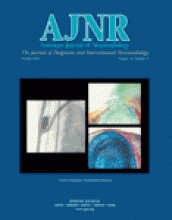Abstract
BACKGROUND AND PURPOSE: Prior reports have described increased signal intensity (SI) of CSF on fluid-attenuated inversion recovery (FLAIR) images of anesthetized patients receiving 100% O2. This appearance can simulate that of diseases. We evaluated the relationship between the concentration of inhaled O2 and the development of increased SI of CSF on FLAIR images.
METHODS: FLAIR was performed in 25 healthy volunteers breathing room air and 100% O2 through a face mask for 5, 10, and 15 minutes. MR imaging, including FLAIR imaging, was performed in 52 patients with no potential meningeal abnormalities under general anesthesia: 21 received an equal mixture of N2O and O2, and 31 received 100% O2. The SI of CSF in volunteers and patients was graded in several locations by using a three-point scale.
RESULTS: SI of CSF significantly increased (P < .05) in various locations, in both volunteers and patients breathing 100% O2, when compared with SI in the same volunteers breathing room air. Hyperintensity of CSF was not significantly different in volunteers receiving 100% O2 through a face mask compared with anesthetized patients receiving 100% O2 through a laryngeal airway or an endotracheal tube. No significant increase in SI occurred in patients receiving 50% O2, when compared with the SI of volunteers breathing room air.
CONCLUSION: Supplemental oxygen at 100% is a main cause of artifactual CSF hyperintensity on FLAIR images, regardless of the anesthetic drug used. This artifact does not develop when 50% O2 is administered.
- Copyright © American Society of Neuroradiology











